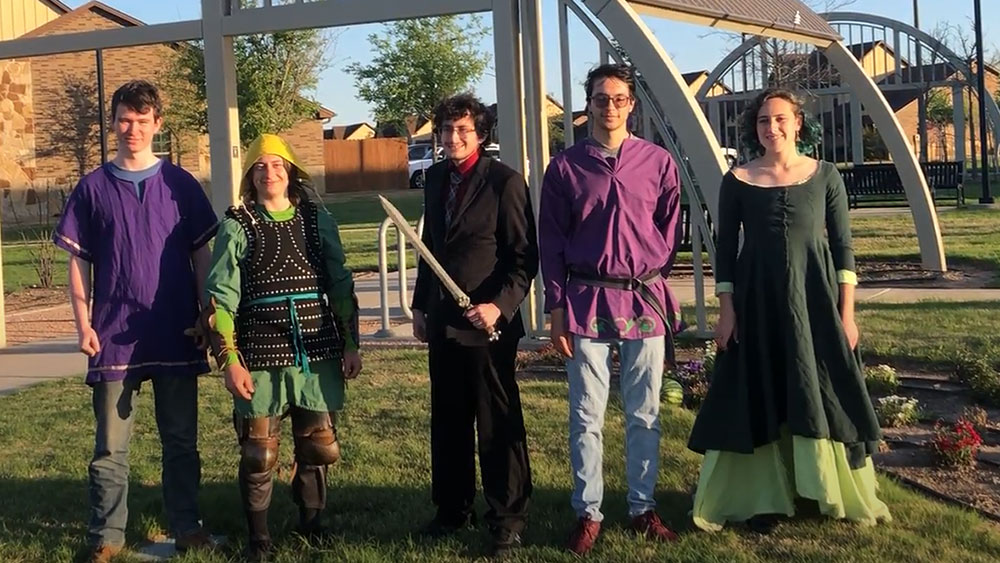
James Gonzales, Bryce Miller, Hadyn Kroen, Esteban Nava Sanudo, and Kenna Ashen from the Department of Materials Science and Engineering won first place for the Best Project Video in the Steel Founders’ Society of America annual Cast in Steel 2022 competition. |
Image: Ankit Srivastava
A team of undergraduate students from the Department of Materials Science and Engineering at Texas A&M University won first place for the Best Project Video, one of the five award categories in the Steel Founders’ Society of America (SFSA) Annual Cast in Steel 2022 Competition held in Columbus, Ohio. The students also earned second place in the Best Technical Report and third place in the Grand Prize categories.
This year’s competition featured over 40 teams from universities across North America. According to the SFSA’s website, the competition challenged the students to creatively design and produce a functioning version of a Celtic Leaf Sword using modern casting tools. Apart from creating the actual sword, the competition required a technical report and a project video documenting the design and manufacturing process.
The team included Kenna Ashen (team lead), Esteban Nava, Bryce Miller, Hadyn Kroen and James Gonzales. Together, they created a unique design based on archeological finds and their own hand-drawn Celtic imagery with a “Lord of the Rings” theme. The sword was modeled in Solidworks, allowing team members to collaborate with their sponsors to fine-tune the design and prepare the model for casting.
The swords were then 3D-printed in a polymethyl methacrylate polymer and attached to wax molds for investment casting, a method in which a wax mold is coated in a hard ceramic shell and then burned out so that molten metal can be poured in its place. Finally, the students burned the finished sword onto an oak handle and added a decorative glass jewel for the Eye of Sauron in the center of the pommel.
“We really enjoyed the entire process, from designing the sword, prepping the wax molds, watching the metal-pouring process to grinding and sandblasting,” said Ashen. “Filming the project video was a blast. We dressed up in medieval garb and filmed a variety of tests for the sword, all as if filming an infomercial. We actually had a few people drive past and stop to watch us. We then added technical information and some cool videos of us actually making the sword.”
The team worked with Texas Precision Metalcraft, Pyrology Foundry and Studio, and Voxeljet. It also received partial financial support from Nucor Steels.
Dr. Ankit Srivastava, associate professor in the Department of Materials Science and Engineering, advised the team. "It is always exhilarating to see students put their passion and classroom knowledge to work and succeed," said Srivastava.
This year’s competition featured over 40 teams from universities across North America. According to the SFSA’s website, the competition challenged the students to creatively design and produce a functioning version of a Celtic Leaf Sword using modern casting tools. Apart from creating the actual sword, the competition required a technical report and a project video documenting the design and manufacturing process.
The team included Kenna Ashen (team lead), Esteban Nava, Bryce Miller, Hadyn Kroen and James Gonzales. Together, they created a unique design based on archeological finds and their own hand-drawn Celtic imagery with a “Lord of the Rings” theme. The sword was modeled in Solidworks, allowing team members to collaborate with their sponsors to fine-tune the design and prepare the model for casting.
The swords were then 3D-printed in a polymethyl methacrylate polymer and attached to wax molds for investment casting, a method in which a wax mold is coated in a hard ceramic shell and then burned out so that molten metal can be poured in its place. Finally, the students burned the finished sword onto an oak handle and added a decorative glass jewel for the Eye of Sauron in the center of the pommel.
“We really enjoyed the entire process, from designing the sword, prepping the wax molds, watching the metal-pouring process to grinding and sandblasting,” said Ashen. “Filming the project video was a blast. We dressed up in medieval garb and filmed a variety of tests for the sword, all as if filming an infomercial. We actually had a few people drive past and stop to watch us. We then added technical information and some cool videos of us actually making the sword.”
The team worked with Texas Precision Metalcraft, Pyrology Foundry and Studio, and Voxeljet. It also received partial financial support from Nucor Steels.
Dr. Ankit Srivastava, associate professor in the Department of Materials Science and Engineering, advised the team. "It is always exhilarating to see students put their passion and classroom knowledge to work and succeed," said Srivastava.